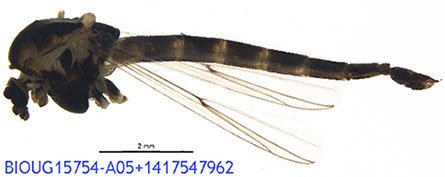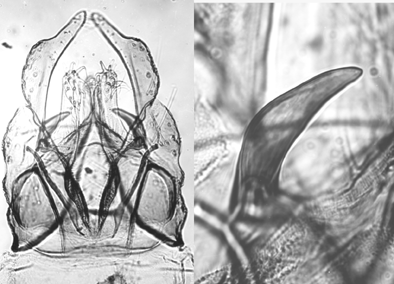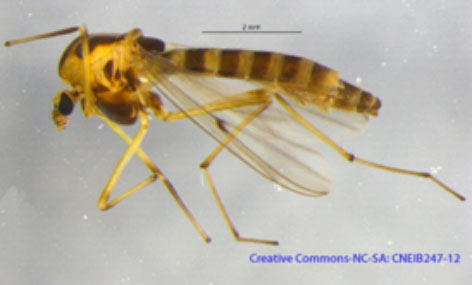Species a. C. bifurcatus Wülker et al., 2009 A member of the C. decorus group.Also C. species B1 = C. decorus-gr sp.1 of Butler et al. 1995.
In BOLD Bin: BOLD:AAG5453 (Gp. 1) Adult:The adults and other life stages were described by Wülker et al. (2009).. However, these descriptions are probably a mixture of specimens of C. bifurcatus and C. "proulxi", so need to be revised. Male: The adult male is a typical member of the C. decorus-group. Rather similar to those of C. maturus Johannsen in coloration and in the darkened superior volsella of the male genitalia, but the superior volsella is shorter and darker than that of C. decorus.
Coloration. Head and thorax dark brown, postnotum blackish, scutellum paler, median and lateral vittae weakly separated by lighter colour; abdomen strongly vittate, with the basal dark bands occupying half or more of each tergum, except on tergum VI where the dark marking is more saddle-shaped, as C. decorus; legs pale yellowish brown.Head. AR 4.14 (3.33-4.21); temporal setae 32 (29-32); clypeus about 0.84 width of antennal pedicel; clypeal setae 32 (27-40); frontal tubercle length 42-86 µm; length of palps (segs. II-V) (µm): 62: 226: 273: 383; P5/P4 1.40, P5/P3 1.69.
Thoracic setae – Acrostichals abt. 16; dorsocentral 27, mostly in 2 rows; prealar 6; supraalar 1; scutellar 30, with 15 in posterior row, rest scattered anteriorly.
Wing length 2.87-3.95 mm; width 0.92-1.00 mm; VR 0.99 (0.98-1.02).
Legs: LRI 1.58; LRII 0.62; LRIII 0.77; BR 3.0.
Leg lengths and proportions:
| Fe
| Ti
| Ta1
| Ta2
| Ta3
| Ta4
| Ta5
| LR
| F/T
| BR
| PI
| 1190
| 1190
| -
| -
| -
| -
| -
| 1.51-1.68
| 1.0
| 2..31-3.57
| PII
| 1385
| 1150
| 730
| 385
| 230
| 190
| 150
| 0.61-0.66
| 1.18-1.20
|
| PIII
| 1385
| 1190
| 1150
| 615
| 405
| 365
| -
| 0.71-0.80
| 1.0-1.16
|
| Some measurements of a confirmed specimen can be provided from the photograph of a male in the BOLD database; and for the hypopygium, from an adult from the same egg mass as the Holotype::  Wing length 3.8-4.1 mm, width 0.9-1.0 mm. Wing length 3.8-4.1 mm, width 0.9-1.0 mm.
Basal dark band at anterior of abdominal tergites, broader at mid-line and becoming more extensive until segs. VI-IX are almost completely dark.
About 7-8 setae in a single patch on TIX.
Male terminalia of C. bifurcatus.
Adult from the same egg mass as the HolotypeA typical C. decorus-type hypopygium, with superior volsella similar to that of C. maturus.
Anal point relatively broad, Superior volsella dark in type egg mass but paler in some other specimens, of D-type of Strenzke (1959); Inferior Volsella reaching just beyond the end of the anal point and to about the midpoint of the Gonostylus, which is moderately swollen and narrows sharply over posterior third. Female: Most information from photographs on BOLD.  Coloration essentially as in the male; abdomen with dark band on basal half of segment. Legs pale with some darkening at knees and on apical part of tibia, particularly on fore legs.
Wing length about 3.48-4.1 mm, width abt 1.02 mm; VR 0.92-0.95; abt 21 setae on squamal fringe; 3-4 SCf on brachiolum.
Antennal proportions (micron) 190 : 120 : 125 : 115 : 185; AR - 0.34; A5/A1 - 0.97.
Cephalic tubules about 28-32 µm long and about 1.4-1.6 times longer than wide.
Clypeus about twice the width of the antennal pedicel, about 39 clypeal setae. Palpal proportions (micron) 65 : 50 : 190 : 230 : 310; A5/A4 about 1.35.
Thoracic setae: Acrostichal 17-18; Humeral 7-8 in patches + abt 4 linear; Dorsolateral abt 23-24 if H setae are recognized, otherwise abt 30-35 DL+H; Prealar 6-7; Supraalar 1: Scutellar 15 scattered anteriorly, 14 in posterior row.
Approximate leg proportions (micron):
| Fe
| Ti
| Ta1
| Ta2
| Ta3
| Ta4
| Ta5
| LR
| F/T
| Ta4/Ti
| PI
| 1
| 1205
| 1750
| 945
| 710
| 565
| 320
| 1.39-1.56
| 1.0-1.09
| 1.7-2.0
| PII
| 1325
| 1265
| 750
| 445
| 320
| 220
| 165
| 0.58-0.62
| 1.03-1.07
|
| PIII
| 1545
| 1590
| 1180
| 685
| 500
| 335
| 195
| 0.72-0.76
| 0.93-0.99
|
| Immatures and Cytology Found: Ontario – Algonquin Provincial Park (abt 45.58, -78.70), Nipissing Co.; Bear Creek, nr. Carlsbad Springs (45.37, -75.47), Russell
Co.; Copanspin Farm, Dunrobin (45.75, -75.87), and 0.5 ml. Dunrobin; Arboretum, Ottawa; Lac Deschêne (45.37, -75.85)
(Type locality); Ottawa (45.40; -75.87); South March (45.40, -75.87), (all Carleton Co.): McFarlane L. (46.42, -80.95) and
Tilton L. (46.35, -81.07), Sudbury area (Proulx et al.)
Quebec – Brewery Creek, Hull (45.43, -75.73); L. D'Allembert (48.38, -79.02), L. St. Joseph (46.88, -71.63),
L. Arnoux (48.25, -79.33), L. Kinojévis (48.13, -78.90) and L. Duprat (48.33, -79.12) (Proulx et al.).
Kansas – Lone Star Lake (38.83, -95.38), Douglas Co.
Massachusetts – Lake Pleasant (43.56, -72.51), nr. Montague, Franklin Co.
Michigan – Lake Michigan, Epoufette (46.05, -85.17).
Minnesota – Anderson Lake, Clearwater Co.; Turtle Lake, Becker Co.; Bad Axe Lake, Hubbard Co. (M.G. Butler)
Wisconsin – Arboretum (43.03, -89.42), Madison, Dane Co. Creeks, pools, shallows to profundal of lakes. All life stages (except female) and the salivary gland chromosomes described by Wuelker et al. (2009). Some information on arm F given in Fig. 3 of Martin (1979) and a photograph of the chromosomes in Butler et al. (1995) as C. decorus-gr. species 1. DNA analysis: Sequence for the mitochondrial cox 1 and the nuclear gb2Β genes are available.This data (Proulx et al. 2013) is suggesting that the species may comprise two closely related components. The data is for only a small number of specimens, but they show different bases between the groups at seven sites (see Table below). (base no.) 1 2 3 3 3 4 4 5 5 6
9 7 3 4 8 7 9 1 6 2
7 1 6 2 1 7 8 6 4 1
Group 1
L. D'Allembert QC 12 C C TT A T C C A A
L. Arnoux QC 11 C C T T A T C CA A
L.St Joseph QC C C T T A T A C A A
Pleasant L.,MA21f C C T T A T C C A A
Group 2
McFarlane L. ON 7 T G A C TA T T T T
Tilton L. ON 8 TG A C T A T T T T
L.St Joseph QC T G A C T A T TT C
Madison WI em#8 T A A C T A T T A C
Madison WI em#7 T A A C T A T T A C
L.Kinojévis, QC T G A C T A T TT C
Sequences of C. bifurcatus specimens used in cox1 ananlysis.
As well these specimens show alternative banding sequences on some chromosome arms, one set of which corresponds to those of the Type egg mass (see Table below).
\ Arm
Specimen \
| A
| B
| D
| E
| F
| G (med BR)
| Group 1
|
|
|
|
|
|
| Pleasant L. MA 21
| A2
| B1
| D2
| E1
| F1
| abs
| L. Dupret QC 10
| A1
| B1
| D2
| E1
| F1
| abs
| L. Arnoux QC 11
| A1.2
| B1
| D1.2
| E1
| F1
| abs
| L.D'Alembert QC 12
| A1
| B1
| D2
| E1
| F1
| abs
| Group 2
|
|
|
|
|
|
| Madison WI em#8
| A3
| B2
| D2.3
| E2
| F2
| pres
| Madison WI em#7
| A3
| B2
| D2
| E2
| F2
| pres
| McFarlane L. ON 7
| A1
| B2
| -
| E1*
| F2
| pres
| Tilton L. ON 8
| -
| B2
| -
| E1?
| F2
| pres
| Type material
|
|
|
|
|
|
| Type egg mass
| A1.2
| B1
| D1
| E1
| F1
| abs
| * itis just possible that this is E1.2 In case this is supported, information on specimens from the same egg mass as the Holotype is provided. See also C. decorus Joh., C. sp. nr. bifurcatus, C. sp. b, C. sp. c, C. sp. j, C. sp. 2a, C. sp. 2b, C. decorus gp. sp. 2, C. sp. 3h, C. sp. 3i, C. sp. 3j, C. harpi, C. blaylocki, C. decorus R & F., C. mozleyi, C. winnelli, C. sp. 4l.[ Return to Index| Go to References ] |


